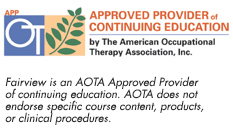|
Advances in Vestibular RehabilitationThis course is on a wait list; if you wish to be placed on the wait continue to register.Course Date: Friday and Saturday, February 28-29, 2020
Course time: Friday Check in time: 7:30-8:00 AM and Course time 8:00-3:15 PM
Saturday start time 7:30-4:00 PM
Course Level: Advanced
Intended Audience: PT, PTA, OT
Prerequisite: Experience working with this clientele.
Course Location: M Health Fairview Southdale
6401 France Avenue S. Edina, MN 55435
International Room A and B
Course Fee: $425.00
Contact Hours 14.0 MN Board of PT approval pending. (Hours subject to change slightly depending on approval).
Course intended to be completed in full. If you need to arrive late or leave early the CE department must be notified before course takes place for contact hours to be adjusted. PT/PTA partial credit: Hours for partial credit attended will be adjusted on your course certificate and MN board of Approval number removed. You may still be able to submit the hours attended towards your professional license. AOTA: Hours for partial credit will be adjusted on your course certificate. OT/COTA are able to claim the hours actually attended. AOTA logo will remain on course certificate.
Cancellation Policy: Cancellation Fee will apply Group Discounts: If three people from the same organization register for a course, each person will receive a 10% discount. Four or more registered will receive a 15% discount. Please email or call ahead of time with the names of the people who will be registering as a group, [email protected] or 612-672-5607. For Group discounts: USE CODE rehab10 for 10% discount and rehab15 for 15% discount for group. Course Description
Dizziness is the number one cause of office visits to physicians for patients over the age of 65. The most common cause of dizziness is Benign Paroxysmal Positional Vertigo (BPPV). In one study of older adults, 1 out of 10 persons presenting to the clinic for other medical conditions had un-diagnosed BPPV. The persons with BPPV also had a higher incidence of recent reported falls. BPPV can be seen post-operatively or after a fall. Falls and dizziness are also a leading cause of hospital admissions with high rates of mortality and morbidity. As rehabilitation professionals, we are often called on to treat persons with balance and/or dizziness impairments. How can we determine if the problem is medical, mechanical, or from the often-misdiagnosed problem of benign paroxysmal positional vertigo? This course will provide you with the tools to be able to deferentially diagnosis what conditions are within your scope of practice and which patients should be referred for additional follow-up care. In addition, the program will provide hands on practice and differential diagnosis skills for identifying both peripheral and central vestibular disorders. All participants will have an opportunity to practice evaluation techniques and interventions for the treatment of BPPV and other vestibular disorders.
Speaker
Susan L. Whitney, DPT, PhD, NCS, ATC, FAPTA received her PhD in motor development/motor learning from the University of Pittsburgh and her professional physical therapy education from Temple University in Philadelphia, PA. Currently, she is a professor in physical therapy in the School of Health and Rehabilitation Sciences and in the Department of Otolaryngology in the School of Medicine, University of Pittsburgh. She works at the Centers for Rehab Services (CRS) Vestibular Rehabilitation practice at the Eye and Ear Building within the University of Pittsburgh Medical Center. She has published over 145 papers that are referenced on Medline and has written over 35 book chapters, primarily in the area of functional balance assessment and vestibular rehabilitation. Dr. Whitney is past President of the Neurology Section of the American Physical Therapy Association. She was a member of the first BPPV guideline task for of the American Academy of Otolaryngology, Head and Neck Surgery and a member of the vestibular hypofunction CPG group for the Academy of Neurologic PT.
Learning Objectives
Upon completion of this course the participants will be able to:
Lunch will be provided on First day, second day lunch is on your own FRIDAY: 6.50 contact hours
7:30-8:00 AM Check in and Continental Breakfast
8:00-8:30 AM Vestibular Anatomy and Physiology-a quick review
8:30-10:15 AM Differentiating central from peripheral Vestibular disorders
10:15-10:30 AM Break
10:30-12:00 PM Differential diagnosis of various vestibular/brain disorders: When to treat and when to refer
12:00-12:30 PM ( Lunch will be provided) Pizza and Gluten Free pizza, Salad
12:45-2:45 PM Differential diagnosis of various vestibular/brain disorders: When to treat and when to refer
2:45-3:15 Lab Session: Practice of the Canalith re-positioning maneuvers for posterior, anterior and horizontal canal BPPV with emphasis on the new re-positioning maneuvers in the literature including the Li maneuvers and the vestibular ocular motor screen
SATURDAY: 7.5
7:30-10:00 AM Lab Session: Practice of the canalith re-positioning maneuvers for posterior, anterior and horizontal canal BPPV
10:00-10:15 AM Break
10:15-12:00 PM Cases of persons presenting to an outpatient orthopedic or neurologic clinic with BPPV and other vestibular conditions including concussion and their
management
12:00-12:45 PM Lunch (On your Own)
12:30-2:30 PM Update on advances in the treatment of people presenting with balance and dizziness problems as their chief complaint ( low and high tech)
2:30-4 PM Interesting cases- how to treat and clinical decision making, Case studies, Q&A
AOTA Classification Code: Domain of OT and Occupational Therapy Process MN BOARD OF PT APPROVAL
|


